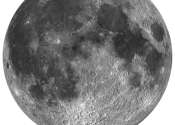How to deflect asteroids and save the Earth
You may want to thank David French in advance. Because, in the event that a comet or asteroid comes hurtling toward Earth, he may be the guy responsible for saving the entire planet.
You may want to thank David French in advance. Because, in the event that a comet or asteroid comes hurtling toward Earth, he may be the guy responsible for saving the entire planet.
Space Exploration
Apr 16, 2009
19
0

Billions of years ago when the planets of our solar system were still young, Mars was a very different world. Liquid water flowed in long rivers that emptied into lakes and shallow seas. A thick atmosphere blanketed the ...
Space Exploration
Nov 13, 2013
21
0

(PhysOrg.com) -- The Moon is a big sponge that absorbs electrically charged particles given out by the Sun. These particles interact with the oxygen present in some dust grains on the lunar surface, producing water. This ...
Space Exploration
Oct 15, 2009
6
0

(Phys.org)—Unlike electromagnetic radiation, which consists of massless and accelerated charged particles, galactic cosmic rays (CR) are composed mostly of atomic nuclei and solitary electrons, objects that have mass. Cosmic ...

Nearly a year and a half into its mission, Parker Solar Probe has returned gigabytes of data on the Sun and its atmosphere. Following the release of the very first science from the mission, five researchers presented additional ...
Space Exploration
Dec 11, 2019
0
454

To the surprise of many planetary scientists, the oxidized iron mineral hematite has been discovered at high latitudes on the Moon, according to a study published today in Science Advances led by Shuai Li, assistant researcher ...
Space Exploration
Sep 2, 2020
8
470

An enormous triangular hole in the Sun’s corona was captured earlier today by NASA’s Solar Dynamics Observatory, seen above from the AIA 211 imaging assembly. This gap in the Sun’s atmosphere is allowing more ...
Space Exploration
Mar 14, 2012
10
0

Ever since the 1950s discovery of the solar wind - the constant flow of charged particles from the sun - there's been a stark disconnect between this outpouring and the sun itself. As it approaches Earth, the solar wind is ...
Space Exploration
Sep 1, 2016
9
657

(PhysOrg.com) -- Scientists analyzing recent data from NASA's Voyager and Cassini spacecraft have calculated that Voyager 1 could cross over into the frontier of interstellar space at any time and much earlier than previously ...
Space Exploration
Jun 15, 2011
13
3

The Moon's south pole region is home to some of the most extreme environments in the solar system: it's unimaginably cold, massively cratered, and has areas that are either constantly bathed in sunlight or in darkness. This ...
Space Exploration
Jul 23, 2019
1
698